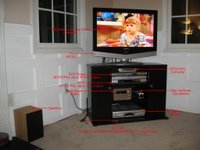Electrics and Electronics

The Sitting RoomWhen one moves overseas, one faces the potentially expensive problem of what to do with one's electrical and electronic possessions. The problem is threefold:
- The mains voltage supply in the UK is 230V and in the US it is 120V
- The UK current alternates at a frequency of 50Hz, whereas the US frequency is 60Hz
- The UK's video colour system is PAL, whereas the US uses NTSC
If you're thinking of moving to the US from the UK, or vice versa, you are bound to be faced with a similar dilemma, so, just in case it helps, here's how we approached the problem:
- We took an inventory of all our electrical/electronic devices along with their voltage/wattage.
For the most part we ignored the frequencies because frequency converters are very expensive and we didn't think that the difference in frequency would adversely affect most of our devices because we were going from 50Hz to 60Hz. If you're moving from the US to the UK, however, you might need to consider this as this may affect some of your decisions.
Some devices, such as many computers (but not all), are built to accept dual voltages, so only needed plug adapters to work in the US. When using adapters, it is worth bearing in mind that some appliances need to be earthed and one would need an earthed adapter for these. - We decided which devices we really wanted to take. These included the TEAC HiFi system and Emily and Lauren's micro systems that were birthday presents and were quite new.
- We decided which devices to give away (such as the washing machine, tumble drier, big TV and vacuum cleaner). We kept one TV and a multi-regional VCR because we have a lot of PAL videos that we wanted to be able to watch in the US, including the "Born in the UK" series of videos that the Everyday Eavesdropper regularly sends us. We also have a PAL PSOne that the children wanted to keep.
- Of the items that we decided to keep, we thought generally about which devices are likely to occupy which rooms (e.g. the food processor would obviously go in the kitchen).

The Kitchen
(the transformer is hidden
in a cupboard)We also kept any extension strips (with rows of UK plug points) to take with us. This was because the plan was to buy a step transformer for each room in which we put UK devices, then plug all the devices for that room into a single transformer via the extension strips. We also had to buy a video converter for the VCR because it turned out that although the VCR was multi-regional in that it could play both UK and US videos, it could only output to a PAL TV. We also found that our TEAC DVD player was not multi-regional and could not be made so using a handset hack, so we would have to spend a fair amount of money to send it off and get it professionally altered. Our solution was to keep the TEAC DVD player boxed and buy a cheap one from Walmart. We then used a handset hack (one types a specific sequence into the remote control to set the region-encoding of the DVD player) to make it play both Region 1 and Region 2 DVDs. (NOTE: To get a handset hack, just google your DVD player's model reference and the words "handset hack".)
We also made sure that the TV we bought had a plug-point for a PC so that we could download or stream UK TV programmes through a laptop computer to the TV. This is much more enjoyable than having to gather around a small computer screen.
We used the wattages that we'd gathered in our inventory to work out the wattage needed for each of the transformers.
As a result, we now have transformers of varying wattages in the kitchen, dining room, sitting room, study and our three bedrooms as well as a number of plug adapters for those appliances that can work on the US voltage. We went for straight-forward transformers rather than the more expensive voltage regulators just to keep costs down, but you might choose to stabilize your voltage with a regulator.
The pictures show a couple of examples.
Here's a few useful links:
Electricity Around the World
PAL SECAM NTSC Conversion
Voltage Guide
World Import FAQs
Frequency: 50Hz vs. 60Hz
DVD Compatibility FAQ


No comments:
Post a Comment